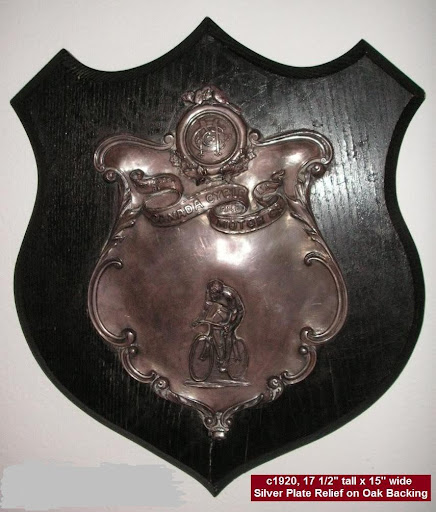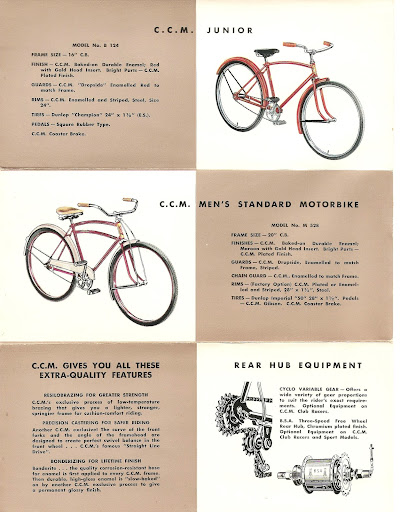Archives
With recent interest on here in the E. & D. bicycle and Dave Brown's photos of his great-looking bike, I thought I'd post the following. Although the Dodge brothers were to become the best-known members of the Evans & Dodge partnership, in the beginning it was actually Frederick Samuel Evans (1857 - 1922) who was the key figure in the company.
Born in Hamilton, Ontario, at the age of 18 Frederick Evans went to work as a telegrapher for the Grand Trunk Railway. By the late 1800s he had arrived in Windsor where he established the Dominion Typograph Company (later known as the Canadian Typograph Company). When he and his company were eventually left out of CCM's purchase of the National Cycle & Automobile Co. in 1900, Evans immediately took CCM and its directors to court. By this time, however, the Dodge boys, who had come to Canada in 1892 to work at Evans' typograph plant, were long gone.
 Walter G. Griffiths, who was an apprentice at the Typograph plant in 1890 – 1895, recalled the arrival of John and Horace Dodge at the plant. The company had placed an advertisement in the Detroit News for “an assembly man, a floor man.” The Dodge brothers came to the plant to see the superintendent, Mr. Piper, looking for work for both. Piper said he wanted only one man, to which John Dodge replied, “We’re brothers and we always work together; if you haven’t got room for two of us, neither of us will start. That’s that!” Piper agreed to hire the pair and told them to report the next Monday. Griffith recalled that John was the more aggressive and hardworking of the two brothers. Horace still went by the name of “Ed.” Both drank heavily on weekends at various taverns in Detroit, but seldom got into fights because they usually drank with each other, apart from others. (The Dodge Brothers: The Men, The Motor Cars, And The Legacy by Charles K. Hyde)
Walter G. Griffiths, who was an apprentice at the Typograph plant in 1890 – 1895, recalled the arrival of John and Horace Dodge at the plant. The company had placed an advertisement in the Detroit News for “an assembly man, a floor man.” The Dodge brothers came to the plant to see the superintendent, Mr. Piper, looking for work for both. Piper said he wanted only one man, to which John Dodge replied, “We’re brothers and we always work together; if you haven’t got room for two of us, neither of us will start. That’s that!” Piper agreed to hire the pair and told them to report the next Monday. Griffith recalled that John was the more aggressive and hardworking of the two brothers. Horace still went by the name of “Ed.” Both drank heavily on weekends at various taverns in Detroit, but seldom got into fights because they usually drank with each other, apart from others. (The Dodge Brothers: The Men, The Motor Cars, And The Legacy by Charles K. Hyde)

John Dodge's E. & D. Bicycle which now resides in the Detroit Historical Museum.
 It was while working as a machinist at the typograph plant that Horace Dodge invented a bicycle bearing that incorporated an enclosed mechanism by which the bicycle rode on four sets of ball bearings. The adjustable four point ball bearing was not only dirt-resistant, but was said to offer a smoother ride with less effort. Horace and his brother John were granted a patent for the bearing in September of 1896.
It was while working as a machinist at the typograph plant that Horace Dodge invented a bicycle bearing that incorporated an enclosed mechanism by which the bicycle rode on four sets of ball bearings. The adjustable four point ball bearing was not only dirt-resistant, but was said to offer a smoother ride with less effort. Horace and his brother John were granted a patent for the bearing in September of 1896.
Shortly thereafter the brothers entered into a partnership with Evans and the trio used a space in the Canadian Typograph plant to manufacture a bicycle using the patented bearing. Known as the “E. & D.” or “Maple Leaf” bicycle, it quickly became a popular model.
In February 1897 Evans displayed the bicycle at the New York Cycle Show and reportedly sold 50 “wheels” to dealers in Philadelphia and New York. In January of 1898, the Canadian Typograph Co. announced plans to open branch offices and retail outlets in London, Ontario and Montreal.
The company also offered bicycle-riding lessons at the Windsor Curling Club. Instruction was free for E. & D. owners and cost $2.00 for five sessions for all others. Separate sessions were offered for the ladies in the morning and mixed sessions for the rest of the day.
In September 1899 when it was announced that five Canadian bicycle companies were to be merged to form CCM, Frederick Evans was irate that his E. & D. bicycle company had not been included. Shortly thereafter (October 1899), he announced the establishment of a Canadian branch plant of the American Bicycle Co., a huge conglomerate of 42 American bicycle makers put together by Colonel A. Pope, maker of the Columbia bicycle, and sporting goods magnate A. G. Spalding.

The Canadian subsidiary of the American Bicycle Co. was to be under Evans' direction and was to be known as the National Cycle & Automobile Co. ("National"). The new company was to include not only the various brands of the American Bicycle Co., but also the E. & D. bicycle and Locomobile motor car.
Evans informed the Canadian public that the bicycle trade previously done in Canada by the companies that were part of the American Bicycle Co. would now be carried on “by a syndicate of Canadian capitalists, who have purchased for Canada from the American Bicycle Co. all their patents, rights, and good-will and business, and will immediately establish in Canada a complete manufacturing plant, capable of turning out not less than 30,000 bicycles per year.” ("Another Great Bicycle Company", Daily Mail & Empire, October 30, 1899)

This shows the various brands carried by National.
You know the chances are slim a company will survive when they mis-spell "bicycle."
Among National's directors were A.G. Spalding (New York), Colonel Pope (Hartford), Edward Stearns (Syracuse) and A.R. Creelman (Toronto). At the time the New York Times reported: “The new company is a branch of the American Bicycle trust, but the Toronto business is largely financed in Canada and will be run chiefly by Canadians.” (New York Times, November 20, 1899)
((

While the company was initially to be located in Toronto, it landed in Hamilton when the Toronto Parks and Garden Committee was slow in finding them a suitable location. The Hamilton deal was set out in an agreement between the bicycle company and the city that called for the city to provide an estimated $20,000 for the construction of a new factory, while the company, in turn, agreed to provide full-time employment for at least 300 men for 10 years.

Dave Brown's E. & D.
When National took over the manufacture of the E. & D. bicycle, they agreed to continue to pay the Dodge brothers royalties for the use of their bearing and offered them both jobs. While Horace decided to remain at the Canadian Typograph plant in Windsor, John headed to Hamilton where he was to be National’s general manager. With anticipation in Hamilton running high, temporary facilities were found for the new firm on Barton Street and John Dodge arrived shortly thereafter to oversee the installation of equipment.
 From the outset, National made a conscious effort to bridge its homeland with its new home. The company crest featured a prominent British lion and an American eagle hovering under a Red ensign with the Stars and Stripes in the background and a banner that read, “The greatest tandem team on earth.”
From the outset, National made a conscious effort to bridge its homeland with its new home. The company crest featured a prominent British lion and an American eagle hovering under a Red ensign with the Stars and Stripes in the background and a banner that read, “The greatest tandem team on earth.”
Meanwhile Frederick Evans tried to soothe away any suspicions Canadians had at the time that National was a backdoor entry for the American takeover of Canada’s bicycle industry. He pointed out that National was not taking business away from any Canadian concern, particularly CCM, since CCM had never controlled the trade of the firms acquired by National.
In fact, pointed out Evans, CCM would be strengthened “by the effectual shutting out of the possibility of competition by unreliable firms, which might make Canada their dumping ground.” The arrival of National in Canada would, according to Evans, “create a healthy competition which will regulate prices in the interests of the purchasers.” ("Another Great Bicycle Company", Daily Mail & Empire, October 30, 1899)
As it turned out, National's stay in Canada was a short one. In November 1900 it was announced that “after prolonged and well considered negotiations,” Canada Cycle & Motor had acquired control of the National Cycle & Motor Co. and all of its Canadian assets.
As part of the takeover, John and Horace Dodge sold their interest in National to CCM for $7,500 and returned to Detroit where they used the money to open a machine shop, eventually becoming famous for the development of the car that would bear their name.
The only brand-name retained by CCM following its take-over of National was Columbia. As a result when Frederick Evans discovered that neither he nor his E. & D. bicycle was to be included in CCM's purchase of National, he immediately launched what was to be a messy and long-running lawsuit against George Cox and the other CCM directors. With the lawsuit taking several months of arguing and legal wrangling, Evans followed the Dodge brothers to Detroit where he helped establish the Commercial Motor Vehicle Co ., a maker of electric runabouts.

IIn the end, Evans' lawsuit against CCM proved to be unsuccessful thus bringing to an end production of the E.& D. bicycle.
Growing up my favourite hockey player was Bobby Hull. Despite living in a household full of Bruins fans, the sight of him winding up behind his own net for an end-to-end rush inevitably started my heart pounding and brought me to my feet.
My first girlfriend once told me I had shhh'd her mother when Hull was in full flight on the family TV. Her annoyance with me for doing so undoubtedly led to the demise of our relationship. C'mon, I said, it was Bobby Hull for god sakes.
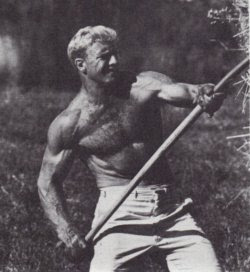
A well-known photo of Hull pitching hay
on his farm just outside of Belleville, ON.
Throughout the sixties no player in the NHL was more recognizable or more feared than Bobby Hull. Hailing from Point Anne, ON, just down the road from my hometown of Kingston, the muscular Hull became known as the “Golden Jet,” hockey's marquee player. With most Canadian homes now having a television set, nothing filled the screen on a Saturday night with more excitement than Hull with his blinding speed, blond hair and blistering shot.
In the latter part of the sixties when CCM looked to launch its new line of medium-priced skates and hockey equipment, company president Tom Nease knew he needed to connect the product to a name and face instantly recognizable by Canadian youngsters. He knew exactly whose face it should be.
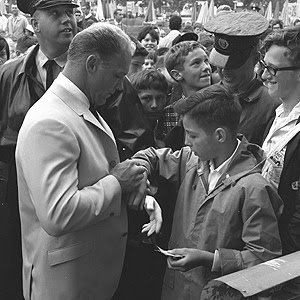 No one drew a crowd on or off the ice like the Chicago star. While Blackhawk owner Bill Wirtz called Hull “the greatest public relations man the NHL ever had,” Time magazine maintained "the sight of Robert Marvin Hull...leaning into a hockey puck to be one of the true spectacles of sport- like watching Mickey Mantle clear the roof, or Wilt Chamberlain flick in a basket or Bart Starr throw that beautiful bomb.”(1)
No one drew a crowd on or off the ice like the Chicago star. While Blackhawk owner Bill Wirtz called Hull “the greatest public relations man the NHL ever had,” Time magazine maintained "the sight of Robert Marvin Hull...leaning into a hockey puck to be one of the true spectacles of sport- like watching Mickey Mantle clear the roof, or Wilt Chamberlain flick in a basket or Bart Starr throw that beautiful bomb.”(1)
Hull's popularity was seen by Nease as the answer to a longstanding question at CCM - how to expand the company's share of the youth market. Despite the stellar reputation of the CCM Tacks, the Tack was an expensive skate and for that reason alone many parents were reluctant to buy them knowing their youngsters would quickly outgrow them. Nease was right. The launch of the Bobby Hull line, marked with Hull's familiar signature, brought CCM instant market appeal at a level where the company had previously struggled.

Such success, however, came with a price. When Tom Nease and Hull's agent met in 1968 to hammer out an agreement between the player and the company, the ensuing contract paid the hockey star $25,000 a year for five years. At a time when endorsement deals were relatively rare, one for $125,000 was simply unheard of.
Advertised as “the greatest name in hockey joins the greatest name in hockey equipment,” the deal was defended by Nease based on its scope. Not only could CCM use Hull’s name and photograph to promote its bicycles and hockey equipment, Hull was committed to making six personal appearances annually on behalf of the company at conventions and trade shows.
Hull, who endorsed everything from Ford cars to Jantzen swimwear, paid little heed to the naysayers who claimed he devoted too much time to his off-ice concerns. When he arrived to sign the CCM contract, Hull used his well-known charm to tell reporters: “I’m going to read this little script. I haven’t had time to memorize it.” (2)
It wasn’t just the money that brought Hull to CCM. He'd been using their skates for some time. In fact, he'd been using them ever since CCM's George Parsons discovered Hull had been cutting the back seam out of his previous skates for added comfort. On catching wind of this Parsons approached the design department at CCM and asked if they could develop a custom-fitting skate with the seam moved to the side. Hull tried it and liked it. Buoyed by this success, the company gambled on him feeling the same way about their hockey sticks.

Although he agreed to give up his Northland Pro for a CCM Custom Pro, Hull maintained an escape clause which allowed him to return to his previous brand of stick, if he could demonstrate that it was "vital to the performance of his work.” (3)
Meanwhile Hull's coach, Billy Reay, was concerned about the cost of the stick. “I hope Bobby put a clause in the contract that says the company (CCM) has to supply him with sticks. You have no idea the number of requests we get for one of Hull’s sticks. It must run into a pile of money,” said Reay at the time. (4)
Even Hull’s team mates benefited from the CCM deal. Whenever the company used Hull’s picture in their promotional material with the club insignia or the Blackhawk name showing, a percentage of the fee was paid to the hockey club for distribution among the other players.

In the end CCM's contract with Hull was not renewed, for while it had landed the Golden Jet on the cover of Time, it had landed Tom Nease in a lot of hot water with the company's owners, the Levy brothers, who felt the deal was simply too rich for their taste.
1. "Hawk on the Wing," Time, Vol. 91 No. 9, March 1, 1968, p. 54
2. Milt Dunnell, "The Trouble With Bobby Hull," Toronto Star, February 29, 1968.
3. Ibid.
4. Ibid.
Bobby Hull Makes Hockey History
http://youtu.be/6doRKqexqmU?t=5m15s





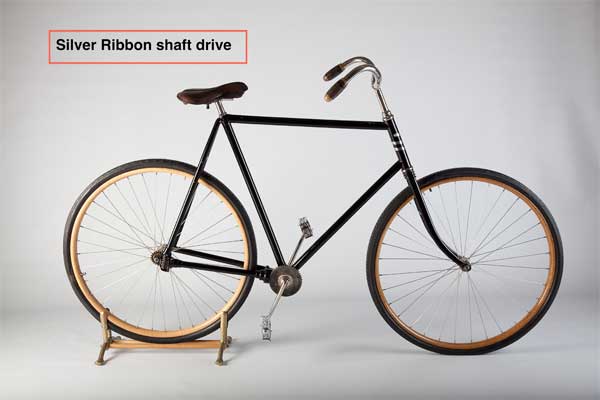




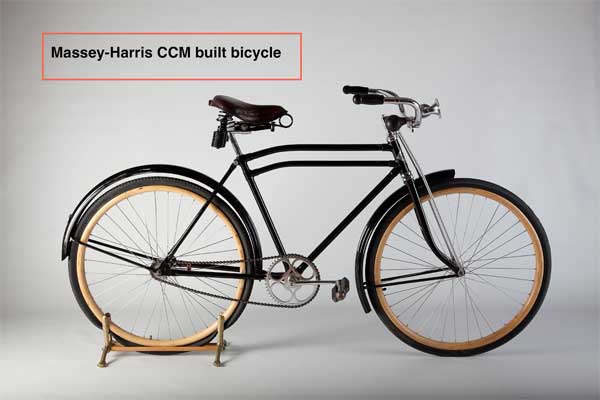
The above bicycles (with the exception of Jack Gordon's) are from the collection of Peggy Eisenbraun and Roger Goodrich. All images are reprinted with the kind permission of the Massey Harris Ferguson Legacy Quarterly.

Hugh Victor McKay
1865 - 1926
Founder of the Sunshine Harvester Works
By the 1920s the Sunshine Harvester Works of H.V. McKay in Australia was the largest implement factory in the southern hemisphere, covering 75 acres, and was one of the world’s leading international agricultural industries thanks to its development of the world's first self-propelled harvester in 1924. At its peak, the enterprise employed nearly 3,000 workers.
<?xml:namespace prefix = o />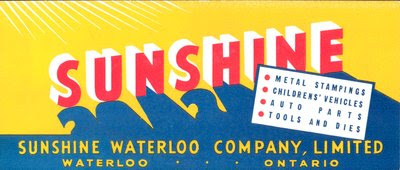
Photo Credit: Waterloo Public Library, Ellis Little Local History Room.
In 1929 McKay and Toronto’s Massey-Harris Co. along with the Waterloo Manufacturing Co. incorporated the Sunshine-Waterloo Company Ltd. with the intent of adapting McKay’s self-propelled combine design for the North American market. In 1930, the newly formed company built a 285,000 sq. ft. plant in Waterloo, Ontario. In exchange McKay was granted the exclusive Australian distribution of Massey-Harris farm equipment.
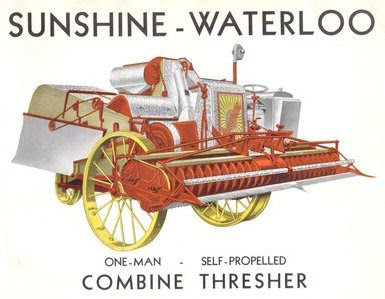
Photo Credit: Waterloo Public Library, Ellis Little Local History Room.
Although set up to produce mainly farm equipment, in order to survive the tough economic times of the thirties, the new company manufactured a multitude of products, including baby carriages, bicycles, tricycles and roller skates. Throughout this period (1930 - 1940) Tommy Russell was president of Massey-Harris and no doubt a key figure in the Waterloo-Sunshine Co.
Sunshine-Waterloo plant in Waterloo, Ontario
Photo Credit: Waterloo Public Library, Ellis Little Local History Room.
During the Depression as grain harvesters were being phased out since farmers could not afford them, the company began to produce automotive stampings for cars. Waterloo Manufacturing withdrew from the joint venture in 1934.
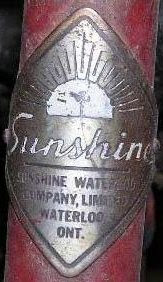

Backpeddling, Guelph, Ontario

Greg Williams' 1952 Sunshine with a Whizzer 300-series motor
In 1955 the McKay family sold out to the newly formed agricultural implement conglomerate Massey-Ferguson which was a combination of the Canadian and American interests of Massey Harris and the British tractor firm of Harry Ferguson.
In 1961 the name of the Sunshine-Waterloo Co. was changed to Sunshine Office Equipment and the company concentrated solely on the manufacture of steel office equipment and storage lockers until the plant was sold in 1978.
Restoring a Canadian Classic –
The ’46 CCM Loop Frame
by Coreen
15 08 2012
The Raving Bike Fiend had offered me this bike some time ago, knowing that I have a soft spot for loop frames, the ability to properly fix it up, and that my own vintage CCM, Poplar, was in extremely poor condition and I was spending more time fixing it than riding it. But with both of us living car free, transporting a non-functional bike cross town can get a little complicated. With a big trip on the horizon, though, he got his car rolling again and outfitted it with the necessities: racks for multiple bikes.

Keith loads up the '46 CCM and le Mercier beside it to get me and my bikes home. This wwould be the first time in months that I'd stepped inton an automobile.
The bike was given to Keith by another BikeWorks volunteer, whose grandmother was the original owner. In remarkably good shape, the burgundy rims still had their original white pinstriping, though the striping on the frame hasn’t fared as well over the decades and the white paint on the chain guard and fenders was particularly rough. It was missing a pedal, chain, grips, saddle and seatpost but still had all its integral components. However, the important question was how it looked on the inside.<?xml:namespace prefix = o />
The first step was to replace the missing components and get it ready for a test ride. Keith gave me a new old stock CCM seat post and I lucked out tremendously and found a Wrights leather saddle (history note – Wrights was an English manufacturer that was bought out by Brooks in 1962). With a brand new 1/8″ chain, it was starting to look like a whole bicycle again but started getting complicated when I went to install pedals.
I had found an appropriate set of 1/2″ pedals and had them ready to go when, after much grunting, swearing and penetrating lube to get the old one off, surprise! I discovered one side of the 1 piece crank was drilled 1/2″ and the other side was drilled 9/16″. WTH? Why would anybody do that? Did they start on the right side before realizing the left side was reverse threaded and needed a special tap? Disappointed that I wouldn’t be able to use the awesome pedals, I headed to the parts room to see if, by some major minor miracle, I could find a matched pair of mismatched pedals. Luck was on my side again, and you wouldn’t know they weren’t a pair by looking at them.
Keith had mentioned some concerns about the coaster hub, so I started the overhauls with that. Old CCM coaster hubs are fairly different than any other coaster hubs I’ve worked on, so if any of the parts were worn, finding spares would be an issue. Though very grimy on the outside, I was pleasantly surprised to find pretty clean lube and all the parts in excellent condition when I opened it up. When I tell people that hubs can outlast bikes if they’re taken care of properly, this is exactly what I’m talking about. This 66 year old hub was in better condition than a lot of 2 year old hubs I’ve seen.

A large part of a project like this is cleaning. There's a nice cog under all that caked-on grime, waiting to be exposed with degreaser and some elbow grease.

The parts of the coaster hub before re-assembly. If you look carefully, you'll see that every part, even the nuts, are stamped "CCM." I don't know why, but it makes my heart skip a beat in joy.

Re-assembled and shined up CCM coaster hub. made in Canada, patented 1937.

Despite the watery surprise on the inside, the races, cups and chrome were in beautiful shape underneath the grime. Also, this is, by far, the best photo of anything I have ever taken inside BikeWorks.
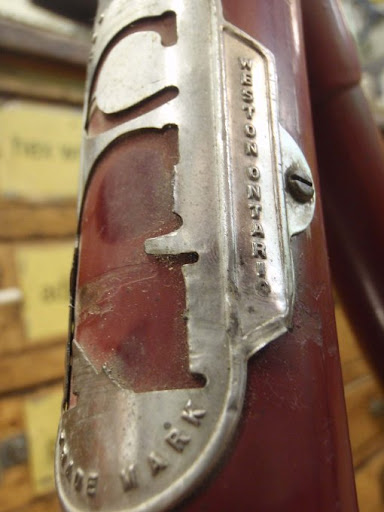
The headbadge has seen better days, my guess is because of a basket. notice how the paint is unevenly faded where parts of the badge have chipped away.

Two light coats of all-in-one Minwax stain/sealer on plain light beige cork. i then used a layer of double-sided tape to keep the grips in place.
The last step was take it for a late night test ride!

The bear was also excited about this old school bike and wanted to take it for a test ride too.

I don't care how late it is. I need to test ride this baby.
Reprinted with kind permission from Breaking Chains and Taking Lanes.
How about some snow tires for the baby carriage?

Or some fancy blades for the feet?






 The first hockey sticks were carved by Mi'kmaq natives of Nova Scotia. They used a wood called hornbeam, also known as ironwood because it is so strong. The best trees for making sticks had roots that grew out in the correct angle for a stick blade. When the hornbeam was used up, the carvers turned to yellow birch, another hard wood. The early sticks looked more like today's field-hockey sticks, with a blade that curved up. They were also shorter and heavier. As hockey grew in popularity, the Native carvers could not make the sticks fast enough for everyone who wanted one. The Starr Manufacturing Company of Dartmouth, Nova Scotia, began making hockey sticks. They called their sticks Mic Mac, after the original makers. These sticks were popular in the 1930s.
The first hockey sticks were carved by Mi'kmaq natives of Nova Scotia. They used a wood called hornbeam, also known as ironwood because it is so strong. The best trees for making sticks had roots that grew out in the correct angle for a stick blade. When the hornbeam was used up, the carvers turned to yellow birch, another hard wood. The early sticks looked more like today's field-hockey sticks, with a blade that curved up. They were also shorter and heavier. As hockey grew in popularity, the Native carvers could not make the sticks fast enough for everyone who wanted one. The Starr Manufacturing Company of Dartmouth, Nova Scotia, began making hockey sticks. They called their sticks Mic Mac, after the original makers. These sticks were popular in the 1930s. 
The first recorded production of hockey sticks in Canada was carried out by the Mi'kmaq natives of Nova Scotia, who carved them out of a wood called hornbeam, also known as ironwood because of its strength. When the hornbeam was used up, the carvers turned to yellow birch. The early sticks looked like field-hockey sticks with a blade that curved up. They were shorter and heavier than the sticks that came to be used in later years.
As hockey grew in popularity, the Native carvers couldn't keep up with the demand. As a result, the Starr Manufacturing Company of Dartmouth, Nova Scotia, began manufacturing hockey sticks and calling them Mic Macs in honour of the original makers.
Having distributed sticks and other hockey equipment for various companies over the years, in 1933 Canada Cycle & Motor acquired an interest in the Jos. Choquette Wood Specialties Co. Ltd. of St. Jean, Quebec. The Quebec company had been founded in 1919 by brothers Joe and Ed Choquette, who started out making hockey sticks in the rear of their sporting goods store on City Hall Avenue in Montreal before moving production to the factory in St. Jean.



Three different views of the Choquette factory in St. Jean, Quebec
According to the Choquette brothers for a hockey stick (usually elm or ash) to be strong, the wood had to be light, straight and have few marks on it. On one occasion to demonstrate the truth of the claim, Ed Choquette stepped up to the huge rack of sticks in the Choquette store and selected a stick. He then placed one end of the stick on the floor and the other against the rack and jumped on it. While Ed was tossed unceremoniously into the air, the stick stayed in one piece prompting Ed to exclaim: “Now there's a stick you can play hockey with!” (1)

Top left: Five acres of ground piled with choice hand-picked logs to be sawed under the personal supervision of Jos. Choquette.
Top right: Standing is Mr. Ernie Everden, inventor of the C.C.M. laminated model. Sitting is W. Prince also of the factory staff. Both on a tour of inspection.
Bottom left: Mr. J. Howes C.C.M. Ontario sales manager and Mr. C. Lawrence convincing themselves that 12 lbs. of green lumber is used in the making of every C.C.M. hockey stick.
Centre: Note there are no logs of large diameter in this lot. Only second growth small trees are selected. Handle stock for the top three grades of C.C.M. Laminated Ice Hockey Sticks is taken from logs 6” to 9” diameter.
Bottom right: Mr. J.A. Russell and Mr. N.P. Tonkin seen standing between two rows of logs piled shoulder high. Note again uniform size of logs selected for the manufacture of C.C.M. Ice Hockey Sticks.
(From: 1935 CCM Sporting Goods Catalogue)

The first CCM laminated hockey stick was developed by company employee Ernie Everden and left the St. Jean factory in 1935. While early sticks had been made of a single piece of wood with the curve at the bottom created by using steam to cure and bend it, the laminated stick was made of various layers held together by waterproof glue. Everden sought and was granted a patent for a three-piece stick where the shaft and blade are separate, held together by a wooden wedge and glue. Not only was the laminate stick easier to make, there was less waste.
“We can use a lot of lumber in making these that would otherwise have to be scrapped. You see, it’s much easier by this process to make sure that both the blade and the handle are straight-grained and that a light stick will stand up in play,” explained Ed Choquette. (2)

The great Rocket Richard picks a stick from a pile of CCM lumber.
 As time went on, players in the NHL began to ask for lighter sticks. While the standard weight for a stick had been 26 ounces, players looked for sticks that were as light as 17 or 18 ounces. It was a request that didn't sit well with team owners, who were now being forced to pay for an increasing number of broken sticks. Among them was Conn Smythe, the frugal owner of the Maple Leafs, who demanded his players use 25 ounce sticks no matter what their preference.
As time went on, players in the NHL began to ask for lighter sticks. While the standard weight for a stick had been 26 ounces, players looked for sticks that were as light as 17 or 18 ounces. It was a request that didn't sit well with team owners, who were now being forced to pay for an increasing number of broken sticks. Among them was Conn Smythe, the frugal owner of the Maple Leafs, who demanded his players use 25 ounce sticks no matter what their preference.
While hockey sticks were generally made to a club’s guidelines, there were a few players who could ask that their sticks be made to their own specifications. It was a practice that never found favour with CCM for it usually left the company holding a number of unwanted sticks. A player, having had the company make twelve different styles of sticks, then picked one leaving CCM holding eleven. Often the left-over sticks found their way, as “autographed models,” to be sold in Doug Laurie’s sports shop at Maple Leaf Gardens.
By 1940 the Jos. Choquette Wood Specialties Co. Ltd. was a wholly-owned CCM subsidiary known as Cho-Wood Products Ltd. By this time the company was producing 240,000 hockey sticks annually, including 125 different custom-made models for NHL players. In 1946 the company suffered the loss of Joe Choquette who died in a Montreal automobile accident. An avid amateur baseball player, in his early days Choquette had played on a ball team with Howie Morenz and Odie Cleghorn. At the height of the Canadien-Maroon rivalry, when players didn't mingle much, it wasn't uncommon to see the likes of Nels Stewart, Hooley Smith and Howie Morenz together at the same time looking for a hockey stick. It was said that when the players visited Joe Choquette, “they met on common ground.”

For many years the CCM sporting goods line was overseen by George Parsons (1914 – 1998), a former member of the Maple Leafs, who had played in two Memorial Cup tourneys before turning pro in 1935. Parson’s playing career was cut short in a game against the Chicago Blackhawks on Mar. 3, 1939, when the blade of a stick accidentally clipped his left eye cutting the retina and causing him to lose sight in that eye. Denied permission to continue playing, Parsons became a fulltime employee of CCM and eventually its Vice-President in Charge of Product Development.

It was Parsons who oversaw the development of the CCM AcuFlex hockey stick, designed to match the strength of the player with the strength of the stick. Stronger players, according to Parsons, needed a stiffer stick. With each of the AcuFlex sticks marked with bright colour bands, dealers were given a device known as a “Dynamometer”. Developed in conjunction with Dalhousie University in Halifax, the "Dynamometer" was used to measure the strength of the athlete’s grip. Once the appropriate colour was determined based on where the needle of the dynamometer pointed when gripped by the player, the dealer was then able to select the appropriate stick with the matching colour band.

One of the most colourful sticks produced by CCM was for American daredevil Evel Knievel. An avid hockey player, who once played with the Charlotte Clippers of the Eastern Hockey League, Knievel was hired by Toronto Toros' owner John Bassett to take four penalty shots on team goaltender Les Binkley between periods of a WHA game on April 11, 1975. To accomplish the task Knievel was given a CCM stick decked out in his signature red, white and blue colours. With Frank Gifford on hand to cover the event for ABC’s Wide World of Sports, Knievel used the stick to score twice, earning himself $20,000. Meanwhile Binkley used the $2,000 given him for his two saves to take his teammates out for dinner and drinks after the game.
Unfortunately, time and neglect would eventually catch up to the CCM sporting goods factory in St. Jean, Quebec, just as they would to the company's bicycle plant in Weston, Ontario. In November 1982 when Cooper Canada Ltd. was considering making an offer for the St. Jean plant, they a sent a couple of company representatives out to take a look at the operation. What they saw didn't impress them.
TWhen Henry Nolting and Jerry Harder of Cooper Canada Ltd., visited the St. Jean plant, they found only a hundred or so workers still there, most of whom were said to be apathetic and listless. The research and development department (two people) was said to be experiencing problems with their Propacs (CCM’s version of the Cooperall) and working with the Quebec Nordiques to improve the product.
The factory itself was in no better shape. The roof in the stick-making section was leaking; the offices were said to be in a mess and the warehouse was full of old stock. The boot-making operation had fared a little better, according to Harder, and could be transferred to Cooper Canada Ltd.’s Toronto location. In the end, Nolting and Harder determined the assets of the operation were certainly worth no more than “book value” and even that was a stretch. (3) It was a sad end to what had once been a glorious enterprise.
1. "Modern Plant Turns Out 240,000 Hockey Sticks For Twenty-Four Countries," VIM, Vol. 22, No. 2, 1935
2. ibid.
3. Donald H. Thain, "Cooper Canada Ltd.," London: Ivey Publishing, 1983
TttyyyyyyyyTtttthhh
Top left: Five acres of ground piled with choice hand-picked logs – 110M feet at this one mill for sawing under the personal supervision of Jos. Choquette.
Top right: Standing is seen Mr. Ernie Everden, inventor of the CCM laminated model. Sitting is W. Prince also of the factory staff. Both on a tour of inspection.
Bottom left: Mr. J. Howes CCM Ontario sales manager and Mr. C. Lawrence just convincing themselves that 12 lbs. of green lumber is used in the making of every CCM hockey stick.
Centre: Note there are no logs of large diameter in this lot. Only second growth small trees are selected. Handle stock for the top three grades of CCM Laminated Ice Hockey Sticks is taken from logs 6” to 9” diameter.
Bottom right: Mr. J.A. Russell and Mr. N.P. Tonkin seen standing between two rows of logs pilrd shoulder high. Note again uniform size of logs selected for the manufacture of CCM Ice Hockey Sticks.
the
wwww
aaaaaaaaaa















